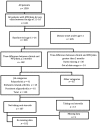Depressive symptoms, pain and disability for adolescent patients with juvenile idiopathic arthritis: results from the Childhood Arthritis Prospective Study
- PMID: 29697850
- PMCID: PMC6055569
- DOI: 10.1093/rheumatology/key088
Depressive symptoms, pain and disability for adolescent patients with juvenile idiopathic arthritis: results from the Childhood Arthritis Prospective Study
Abstract
Objectives: To determine if depressive symptoms assessed near diagnosis associate with future measures of pain, disability and disease for adolescent patients diagnosed with JIA.
Methods: Data were analysed from JIA patients aged 11-16 years recruited to the Childhood Arthritis Prospective Study, a UK-based inception cohort of childhood-onset arthritis. Depressive symptoms (using the Mood and Feelings Questionnaire; MFQ), active and limited joint count, disability score (Childhood Health Assessment Questionnaire), pain visual analogue scale and patient's general evaluation visual analogue scale were collected. Associations between baseline measures (first visit to paediatric rheumatologist) were analysed using multiple linear regression. Linear mixed-effect models for change in the clinical measures of disease over 48 months were estimated including MFQ as an explanatory variable.
Results: Data from 102 patients were analysed. At baseline, median (IQR) age was 13.2 years (11.9-14.2 years) and 14.7% scored over the MFQ cut-off for major depressive disorder. At baseline, depressive symptoms significantly associated with all clinical measures of disease (P ⩽ 0.01). High baseline depressive symptoms scores predicted worse pain (P ⩽ 0.005) and disability (P ⩽ 0.001) 12 months later but not active and limited joint counts.
Conclusions: Adolescent patients with JIA and depressive symptoms had more active joints, pain and disability at the time of their first specialist appointment. The associations between baseline depression and both pain and disability continued for at least one year, however, this was not the case for active joint count.
Figures



References
-
- World Health Organisation. Adolescent Development. 2014. http://www.who.int/maternal_child_adolescent/topics/adolescence/dev/en/ (1 November 2014, date last accessed).
-
- Eleftheriou D, Isenberg DA, Wedderburn LR, Ioannou Y.. The coming of age of adolescent rheumatology. Nat Rev Rheumatol 2014;10:187–93. - PubMed
-
- Petty RE, Southwood TR, Manners P. et al. International League of Associations for Rheumatology classification of juvenile idiopathic arthritis: second revision, Edmonton, 2001. J Rheumatol 2004;31:390–2. - PubMed
-
- Symmons DP, Jones M, Osborne J. et al. Pediatric rheumatology in the United Kingdom: data from the British Pediatric Rheumatology Group National Diagnostic Register. J Rheumatol 1996;23:1975–80. - PubMed
-
- Adam V, St-Pierre Y, Fautrel B. et al. What is the impact of adolescent arthritis and rheumatism? Evidence from a national sample of Canadians. J Rheumatol 2005;32:354–61. - PubMed
Publication types
MeSH terms
Grants and funding
LinkOut - more resources
Full Text Sources
Other Literature Sources
Medical

